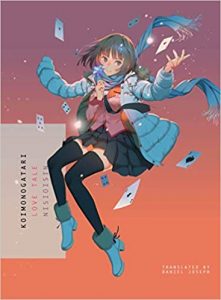By NISIOISIN and VOFAN. Released in Japan by Kodansha BOX. Released in North America by Kodansha Books. Translated by Ko Ransom.
Yes, this is about 3 months late, but now that it’s come out digitally, I can actually catch up with it fairly easily. The final book in the ‘Final Season’ arc, we get to have one last visit with most of the characters we know and love… or do we? Having graduated AND solved the whole Ogi Oshino problem, Araragi is at a bit of a loose end, especially as he doesn’t have his exam results yet. And then as he gets up one morning he finds himself taking a trip through the looking glass… literally. Finding himself in a seeming mirror world, with most of his reliable allies missing, changed, or unhelpful, can he find a way to get back to his own world? Or wait, is this even a mirror world at all? This final volume has all the usual NISIOISIN traits, and rambles on a lot, but mostly is here to show the growth that a lot of characters have or haven’t gotten, and where they could end up in the future.
Featured on the cover is Sodachi and… also Sodachi, and while the alternate selves in this book are largely played with lightly, Sodachi’s own arc in here is tragic, as it has to be. Featuring a girl who was adopted by Araragi’s parents, presumably after discovering her parents’ abuse, she’s well-adjuster, teasing, has a wonderful relationship with Araragi, and is, above all, happy – all things that elude the Sodachi we are all familiar with. In a book looking at things Araragi has regretted, this is his biggest regret, along with Nadeko, and just like Nadeko there’s not much he can do except just stay away from her in the long run. The other reverse character taken seriously is Kissshot Acerolaorion Heartunderblade, who isn’t a vampire in this world but that doesn’t mean she isn’t powerful… TOO powerful, as Araragi witnesses.
Not to spoil anything that’s not already obvious, but the best gag in the book is the fact that, while everyone else in the book is showing their “hidden” other side, Tsukihi is exactly the same because she has no hidden sides. As Ogi said in the previous volume, she lives eternally in the moment. The second best joke in the book is Yotsugi’s sudden expressiveness, a gag that, much like the reverse writing we get for the first few chapters, has to vanish because it’s too much of a pain in the neck. And of course we finally get our first look at Toe Gaen, Kanbaru’s mother and Izuko Gaen’s older sister, who may be dead but that’s not stopping her taking a bath with Araragi, because this is just that kind of series. The book suggests she’s there as a symptom of Izuko’s own regrets, rather than Kanbaru’s, which probably explains why she’s less nasty here than she is in Kanbaru’s dreams. Oh yes, and kudos to Senjogahara for having moved on from imitating Hanekawa on her dates with Araragi to imitating Mayoi.
And so, having fulfilled its final duty to its author – dressing Araragi up in a girls’ uniform, just like Ii-chan in Zaregoto (who is namechecked), the Monogatari Series has come to an end. Oh sure, there’s like 10 more books after this one, but they don’t have an anime, and they are all, with the possible exception of Musubimonogatari, not essential additions to the canon. Not to mention Vertical is now Kodansha Books, who seem a bit more interested in Pretty Boy Detectives and cooking/language books. Will we get more? I’d say it’s as likely as Index: New Testament! Wait, is that good news?














